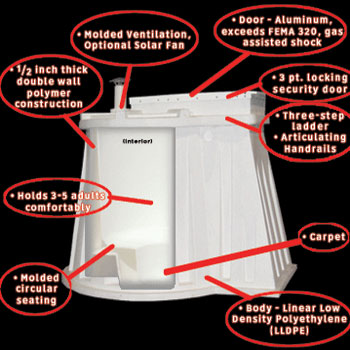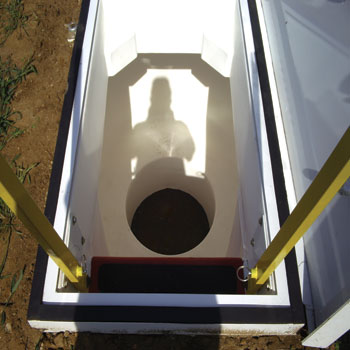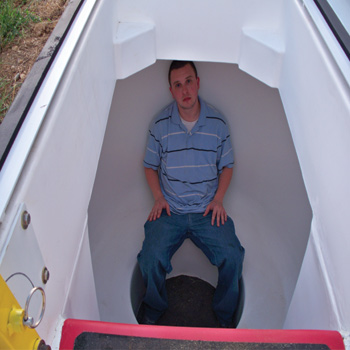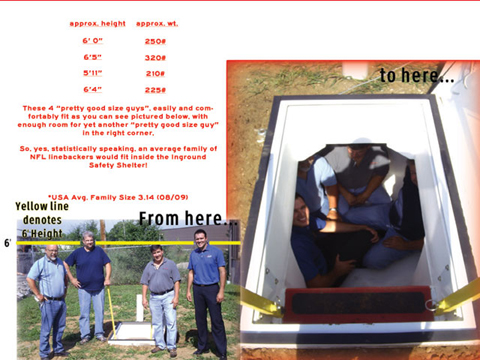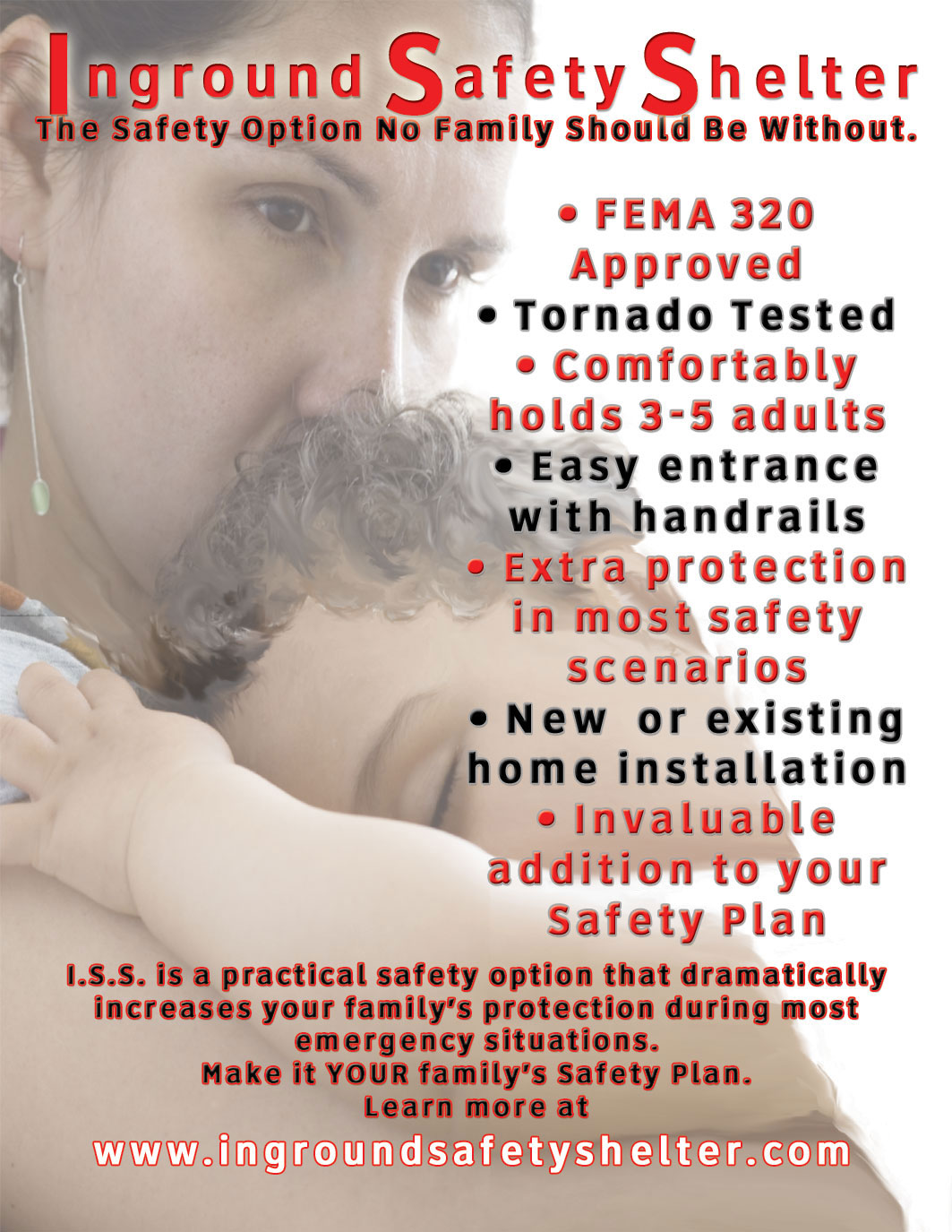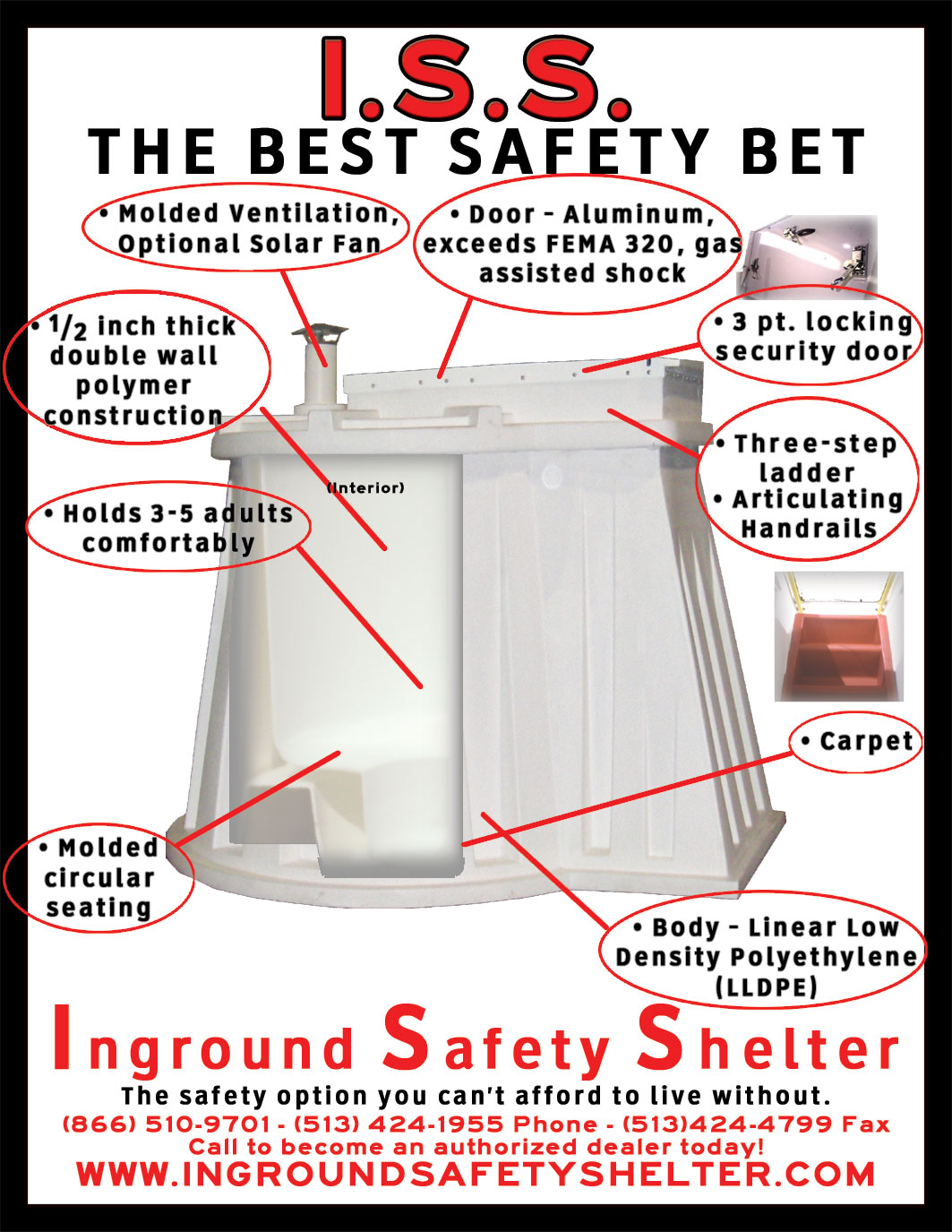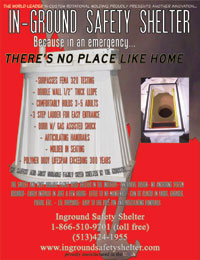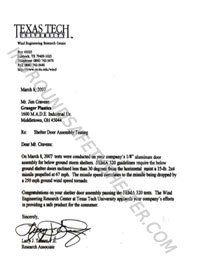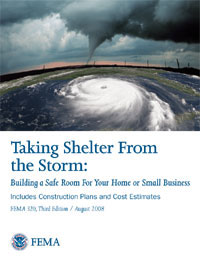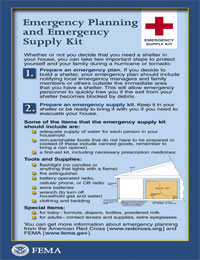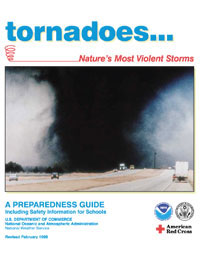About Tornado Shelters
Granger ISS
When most consumers are considering the purchase of a Tornado Shelter, they are taking a conscious effort in providing the safest environment possible for their family. For many, purchasing a Safety Shelter is an investment into their familie's safety for many years to come. Tornado Shelters come with varying features. Some Tornado shelters offer basic protection without offering any "comfort amenities" such as lighting, seating or carpet. Some shelters do not even offer the spacing for any occupants to stand in! The Granger ISS Tornado Shelter is not only one of the most durable Tornado Shelters in the industry, it also offers a complete array of features and amenitites.
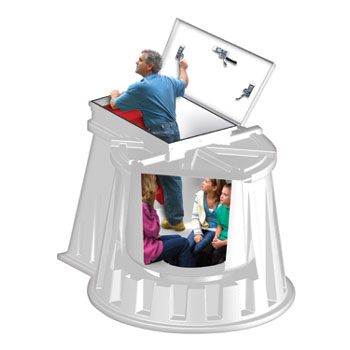 |
Tornado Shelter features
The Granger ISS Tornado Shelter has industry leading features that no other Stom Shelter has including: Scroll over any of ther underlined features to see the Tornado Shelter feature pop up
Tornado Shelter Materials
The Granger ISS is manufactured from Polyethylene, more commonly known as plastic. Polyethylene is not only one of the most durable, long lasting materials known to man, it is also one of the most chemically resistant materials! Common chemicals such as lawn fertilizers, plant foods, weed killers, even gasoline and paint thinners are all common chemicals that will attack and break down inferior Shelter construction materials such as Fiberglass (FRP).
Fiberglass Tornado Shelters

Fiberglass exhibits poor physical properties and resistance to many chemicals and solvents, many of these are commonly used around the house and yard. Fiberglass also breaks down rapidly when exposed to UV for any extended periods of time. Therefore, any Shelter manufacturer or dealer who stores their Fiberglass Units outside, only demonstrate their ignorance about their own products and the materials.

|
As many boat manufacturers will tell you, even high dollar fishing boats are prone to deterioration and or even "fiberglass rot". Fiberglass when exposed not only to UV, but constant moisture, acidic and basic soils and the ground pressure all aide in the oxidation and degredation of the exterior of the unit, when it is installed into the ground. As the oxidation continues to occur and the moisture content continues to increase from the exterior of the shelter, mold and mildew will continue to grow on the exterior surface of the Fiberglass Shelter, thus continuing the decomposistion of the Fiberglass Tornado Shelter. Just as a Fiberglass Yacht will oxidize over time, and if not properly maintained, the yacht will eventually begin to crack and leak water into the boat. If it can happen to multi-million dollar boats manufactured by world leaders in the boating and fishing industries, why would it not happen to a Fiberglass Tornado Shelter? If this problem plagues multi-million dollar companies, would it not also plague the guy who's building Tornado Shelters in his barn out back?
The article below comes from leading yacht manufacturer, Arcturos Yachts, explaning why Aluminum Yachts are superior and preferred over Fiberglass yachts.
Fiberglass or FRP is a thermoset plastic. This thermoset plastic material actually has a small amount of the properties of a thermoplastic, such as Polyethylene (PE), Polyvinyl Chloride (PVC) and Polypropylene (PP), but very miniscule in comparison to the actual thermoplastics. Fiberglass as many experts will tell you from the boat and automotive industries, is not only susceptible to UV degradation, but it also will rot and mildew. Many boat marina's and boat dealers will tell you a large complimentary business to their boat sales is the continaul repair and maintenance of the fiberglass hulls of the boats. Even properly stored, Fiberglass is continously susceptible to the elements. Why risk the liability, exposure and years of on going, expensive & labor intensive maintenace headaches to keep a Fiberglass Shelter viable? Less scrupulous Shelter dealers and manufacturers will tell you that Fiberglass is a superior material at a lessened price, only to find out the overrall cost in the end of the Fiberglass is significantly more, by the time you add the additional intial material expenses such as the multiple yards of concrete needed to most other Tornado Shelters, the elevated freight expense and the heightened labor costs. All of this, in addition to the greatly increased amount of maintenance drastically makes the Polyethylene Shelter a better vaule for single family homes.
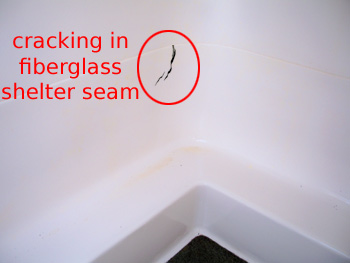
Steel Tornado Shelters
Steel is commonly utilized as a building material for manufacturing Tornado Shelters. We all are relatively familiar with steel as a commonplace material, as we all have been exposed to steel bed frames, steel handrails, steel filing cabinets and even that rusting old beast of a car that used to set in your neighbors yard, rusting away? That was steel! Steel exhibits great physical properties in comparison to other shelter materials such as Fiberglass, however steel has the major issue of rusting that not only makes it very unattractive, but the degredation of the steel during the rusting process deterioriates the physical strength and integrity of the shelter.
Steel Tornado shelters are commonly manufactured from single, 10 gauge steel sheet, which traditionally offers a wall thickness of around .134". This means, that EACH wall of the Granger ISS is approximately 3.7 times thicker than the fabricated 10 gauge steel. The Granger ISS offers a double wall construction, with each of the walls being approximately .500" thick.
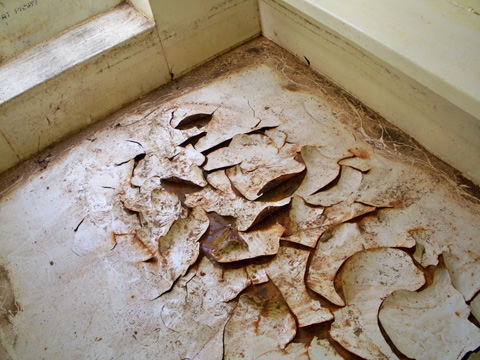 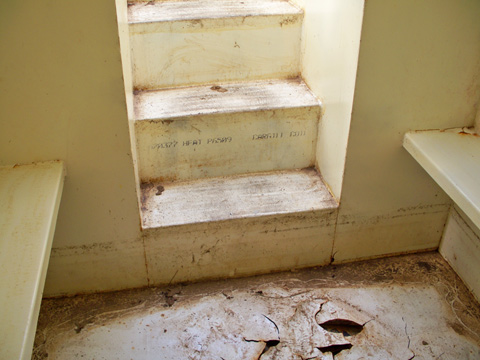
|
While steel offers better physical properties than Fiberglass, it's ability to rust and absorb moisture, chemicals and elements from the ground, make the maintenance of a steel Tornado shelter something that requires a full time staff. As you can see in the picture above, even the best marine paint applications find it nearly impossible to keep the paint adhering to steel due to the continual absorbtion of moisture, the degradation of the steel and the rust that is eating away at the unit like a bad cancer. Steel, when not properly pre-treated prior to painting will continously suffer from filiform corrosion. Filiform corrosion is a typ of corrosion that commonly occurs under painted or plated surfaces. Filiform corrosion normally starts as a small, sometimes microscopic defect in the coating. Filiform corrsosion is minimized by careful surface preparation prior to coating, by the use of coatings that are resistant to this type of corrosion.
Steel Tornado shelters typically use a removable vertical ladder for entry, most of the time this ladder is removed after entry for additional space or to allow the door to close. Many older or disabled customers have often complained about how difficult it is to enter a storm shelter with this type of access, especially in times of an emergency. In some cases attempted entry has resulted in even injury or not being able to get in the shelter at all. A sliding door is also commonplace on many of the steel shelters. Although this sounds like it is a good idea intially most consumer have found numerous problems with this type of entry. An impact to the door or the tracks usually leaves the door difficult or impossible to open. At the time of a Tornado emergency, you may only have seconds separating you and your family from safety and disaster.
Taking these factors into consideration, also allows us to point out that typically, Steel Tornado Shelters usually have Steel entrance doors. Generally, these doors are exceptionally heavy, even with the assistance of either an opening device or some sort of a gas shock. Could your children, mother or grandmother open the tornado shelter door in the time of emergency, or is it going to be too heavy and cumbersome? Is the door still structurally in tact, or has it began to corrode and rust as the steel door pictured below? Would the door below pass the FEMA 320 test in it's current condition?
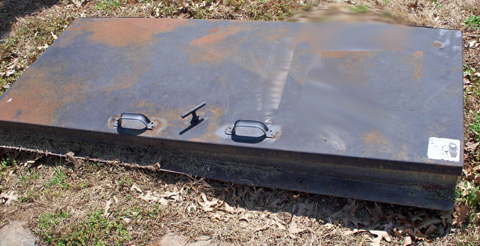 |
With an oncoming Tornado or Storm, the last thing you or your family want to experience is the feeling of being uncomfortable and insecure inside of a damp, dark, rusting storm shelter. Steel shelters potentially require being re-painted, as often as every Tornado Season! Many shelter owners have experienced the need for their shelters to even needing to be re-welded only after a couple of years of installation! Don't subject you or your family to additional labor and maintenance to provide a safe place for your family to take shelter in during a Storm or Tornado!
Concrete Tornado Shelters
Since the days of the World War II era, we have all seen images of concrete bunkers, concrete root cellars in older homes along with old storm cellars. The overwhelming majority of these put into homes thru this time period up thru the Cold War era, were mainly manufactured from concrete. Concrete being widely used and widely accepted as a building material has been used in Tornado Shelters for numerous years. While it displays physical properties that have extreme strength and durability in comparison to lesser capable materials such as Fiberglass & Steel, even concrete suffers corrosion & settling issues.
Concrete is a widely-used structural material that is frequently reinforced with steel. The steel reinforcement is necessary to maintain the strength of the structure. With the steel reinforcement inside of the concrete, the concrete is now subject to corrosion. The cracking associated with corrosion in concrete is a major concern, especially in areas with high humidities, marine environments and in areas which use deicing salts. Concrete corrosion occurs via 2 different ways: (1) Salts and other chemicals enter the concrete and cause corrosion. Corrosion of the metals leads to expansive forces that cause cracking of the concrete structure. (2) Cracks in the concrete allow moisture and salts to reach the metal surface and cause corrosion. While both of these means of corrosion have their advocates, it is possible that corrosion in concrete tornado shelters can happen either way. The means of how the corrosion happened isn't truly important, however the corrosion of the concrete tornado shelter leads to damage and for your Tornado Shelter to function safely and properly, the damage must be controlled. As you may notice with your driveway, sidewalks and highways, concrete expands and contracts greatly as it heats and cools. As the concrete expands and contracts, it cracks all thru the structure of the concrete, degrading the physical strength of the concrete Tornado Shelter. These cracks, require large amounts of maintenace on a regular basis to keep the cracks from growing exponentially fast. Generally, once a crack begins to form in a concrete Tornado Shelter, they will run all thru the shelter, comprimising the integrity of the unit. The Concrete Tornado Shelter will then begin to take on more moisture and even possibly leak ground water into the unit.
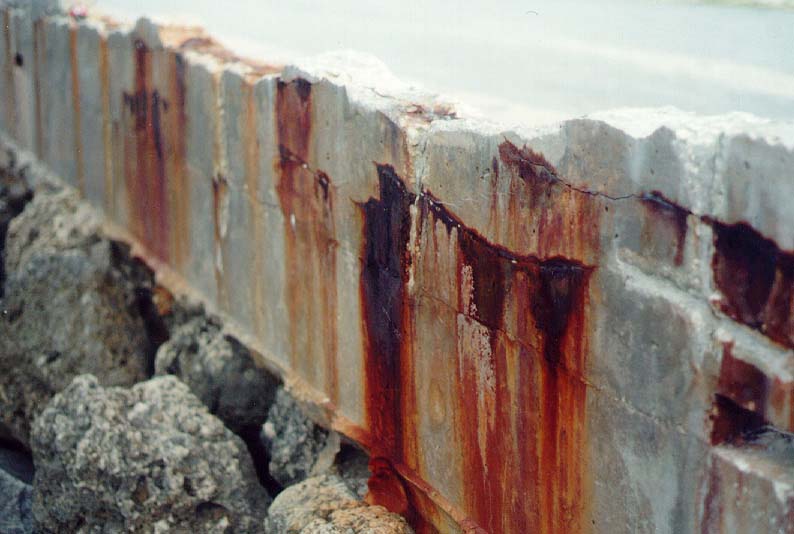 |
Some concrete shelter dealers have even claimed to be able to build a concrete Tornado Shelter at extremely cheap prices, by building the unit from cinder blocks. While the prices quoted are generally "too good to be true", they rarely offer any warranty or maintenance information as to how fast the concrete cinder block units will really last. Pictured below is a snapshot of a concrete Tornado Shelter built from cinder blocks. As you can see in the picture, the unit has deteriorated very rapidly, retaining water & moisture, while cracking thru multiple blocks and in dire need of much repair.
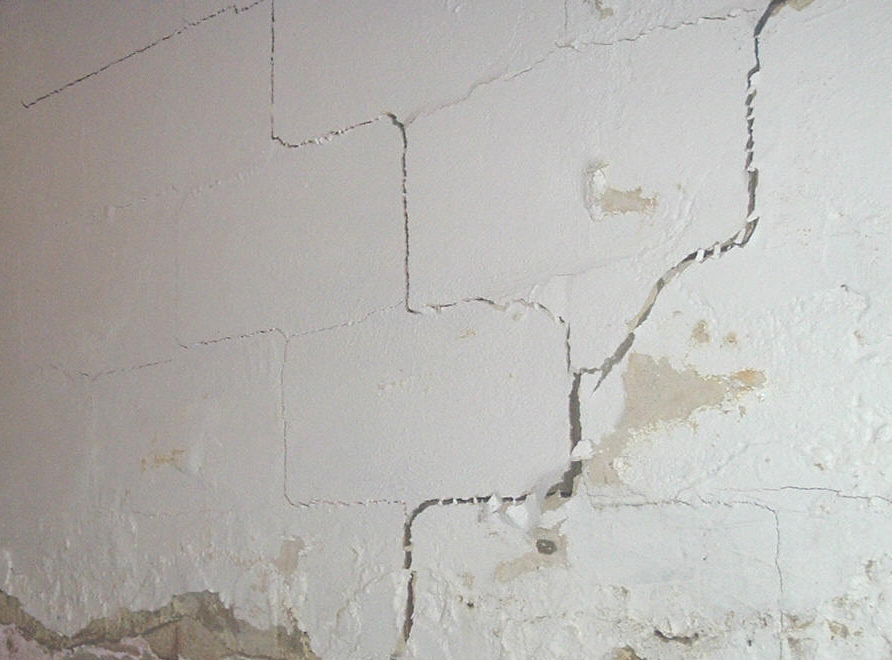 |
Concrete Tornado Shelters generally offer a short term option for a long term problem. What starts as a preventative measure to save a family, many times ends up becoming another home maintenance project along with the yard work, flowers, grass cutting, etc. Within the first few years, if the Shelter owner does not provide adequate attention and maintenance to the unit, it will quickly deteriorate and eventually become a potential safety issue rather than a safety solution. All across the United States, many concrete Tornado Shelters and Concrete Storm Shelters have all become "abandoned". Adding a Tornado Shelter to your families safety plan is not for the additional maintenance and hassle, it should be there to protect your family!
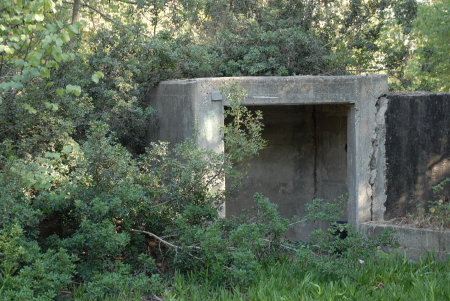 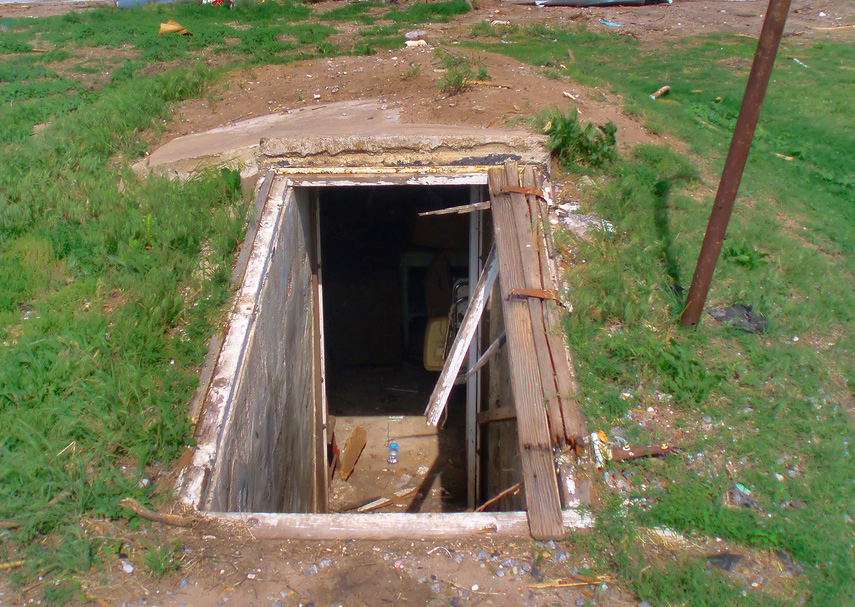 |
Above Ground Tornado Shelters
Many families decide that they would like to add a Tornado Shelter to their families safety plans, generally after a Tornado has caused recent destruction in their local area. While all Tornado authorities such as NOAA, FEMA, CDC, National Weather Service and more, all agree that the safest place to take cover from a Tornado is below ground. Flying debris causes most deaths and injuries during a tornado. The key to surviving a tornado and reducing the risk of injury lies in planning, preparing and practicing what you and your family will do if a tornado strikes. While Above Ground Tornado Shelters are extremely common in some areas, they still do not provide the level of safety and protection by Tornado Shelters that are actually installed underground. The Above Ground Tornado Shelters continue to put your family at risk via the risk of your home collapsing onto the Above Ground Tornado Shelter. Many homes, when hit by a Tornado, tend to collapse due to the destruction and the massive amounts of force and pressure.
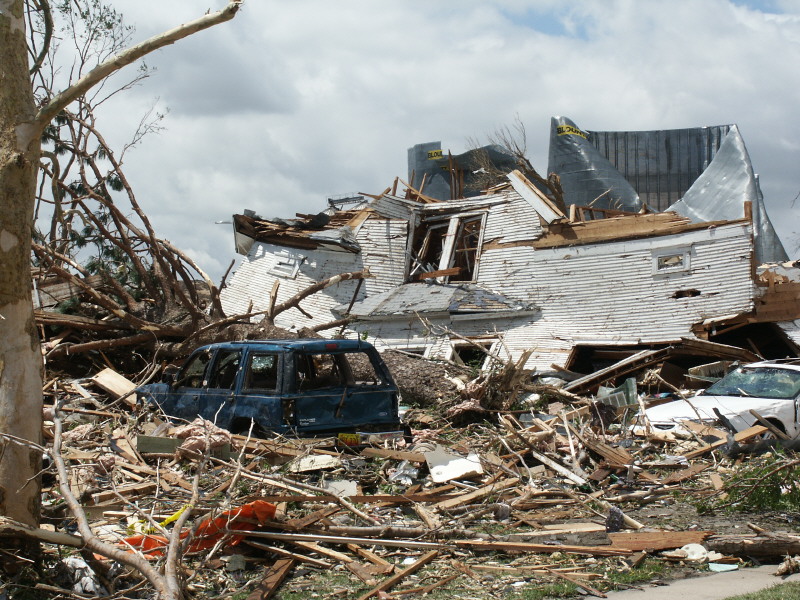
|
As it may seem convenient to have an Above Ground Tornado Shelter close by in your garage, bolted to the floor, you would not want to be trapped inside of an Above Ground Tornado Shelter in the above pictured situation. Just as the inground Steel Tornado Shelters have their issues with corrosion, maintenance and rust, they at least offer a better alternative than the Above Ground Tornado Shelters that are merely bolted to a garage floor. Many above ground Tornado Shelters have a relatively crude appearance, created by poor surface pre-treatment, poor quality paint jobs, bad weld seams and poor assembly quality.
Tornado Shelter Comparisons
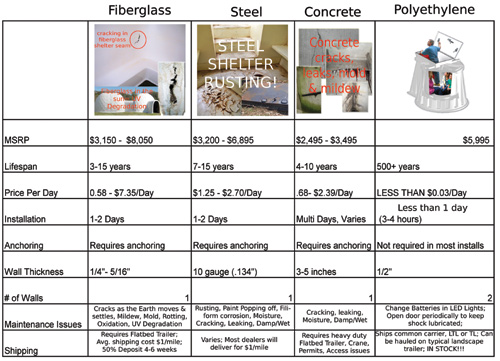
Tornado Shelter Downloads
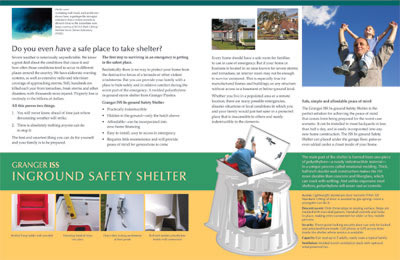 |
